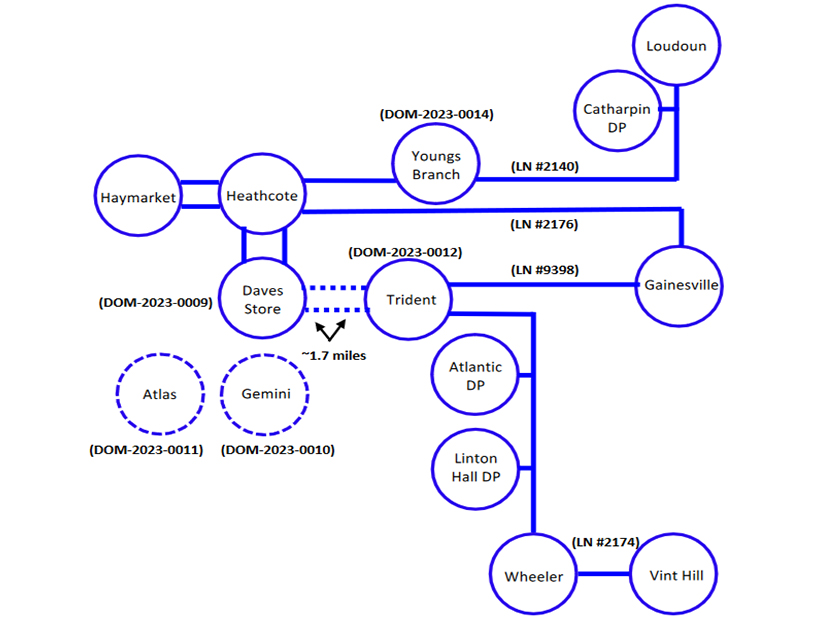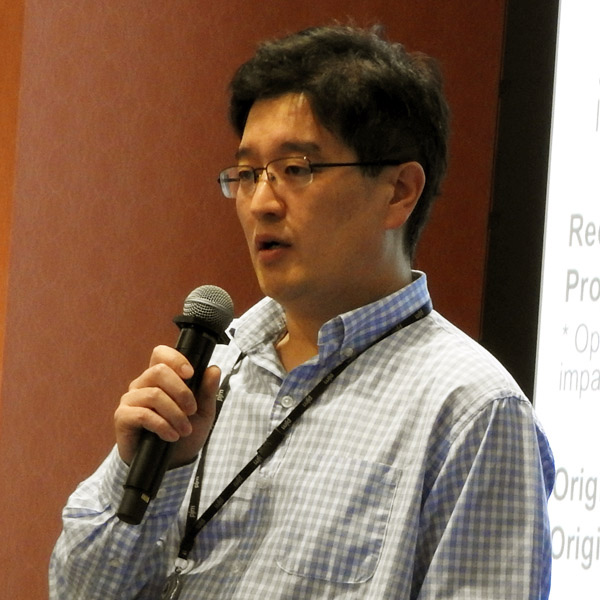
Planning Committee
Stakeholders Endorse Discussion on Deactivating Generators’ CIRs
VALLEY FORGE, Pa. — The PJM Planning Committee on June 6 approved a problem statement and issue charge to explore possible improvements to the existing process of transferring capacity interconnection rights (CIRs) from a retiring generator to a replacement resource at the same interconnection point.
 Tonja Wicks, Elevate Renewable | © RTO Insider LLC
Tonja Wicks, Elevate Renewable | © RTO Insider LLCProposed by East Kentucky Power Cooperative and Elevate Renewables, the problem statement says transfer requests currently have to go through the same backlogged interconnection study queue as new generators to determine if any grid upgrades are required, which can result in replacements for retired facilities taking years to begin construction.
The companies said the long turnaround increases the commercial risk for generation owners seeking replacements; incentivizes speculative projects being submitted in the queue in anticipation of retirements; and contributes to PJM’s concerns about the balance between retiring resources and new entry over the next decade. The problem statement pointed to a February white paper PJM published finding that the pace of renewable development has been slower than anticipated while legislation and economics are leading to more deactivations.
The scope of the issue charge includes only discussion of transfer requests for the same point of interconnection, which EKPC’s Denise Foster Cronin said can often use existing infrastructure and should require no material transmission upgrades. The current process is envisioned to remain for transfers involving different points of interconnection, as those are more likely to require transmission upgrades. The issue charge also aims to develop a solution that specifies that the CIR transfer process applies for all energy-injecting resources, including thermal, renewable and storage.
Responding to stakeholders questioning how a system that allows replacement resources to go through the interconnection process faster would not be skipping other projects in the queue, Paul Sotkiewicz, president of E-Cubed Policy Associates, said the CIRs the replacing resource is seeking are held by the generation owner and are already being modeled as existing on the grid.
“Why can’t those projects be moved forward, because again they’re already being modeled; it doesn’t change anything for anyone else; … it’s not jumping the queue for anyone else; those CIRs are being modeled for everyone else,” he said.
Other PC Business
Stakeholders endorsed PJM’s plan for how it will conduct the 2023 reserve requirement study, the annual process for determining the forecast pool requirement and the installed reserve margin for the following three delivery years and establish the figures for the fourth year out. The study will also set the winter weekly reserve target for the 2023/24 delivery year. (See “Reliability Requirement Study to Use New Software,” PJM PC/TEAC Briefs: May. 9, 2023.)
PJM also provided a first read of the manual changes required to codify the overhaul of the interconnection study process FERC approved in November 2022. (See FERC Approves PJM Plan to Speed Interconnection Queue.)
Transmission Expansion Advisory Committee
Brandon Shores Deactivation to Require $786M in Grid Upgrades
 Phil Yum, PJM | © RTO Insider LLC
Phil Yum, PJM | © RTO Insider LLCThe planned deactivation of the coal-fired Brandon Shores Generating Station, near Baltimore, will require an estimated $786 million to resolve several voltage and thermal violations, PJM’s Phil Yum told the Transmission Expansion Advisory Committee last week.
The violations would spread from the BGE zone to also impact PEPCO, Dominion, PECO, APS, PPL and Met-Ed. The work to the 500-kV grid is estimated at $333 million and includes two new lines between the Peach Bottom and Graceton substations, as well as additional projects throughout the BGE, PECO and PEPCO zones. The 230- and 115-kV upgrades are estimated at $453 million and include three new substations and additional work throughout the BGE and APS zones.
The deactivation is scheduled for June 1, 2025, but Yum said the work is unlikely to be complete before that date. PJM Director of Operations Dave Souder said it will likely be necessary to seek to continue operating the generator under a reliability-must-run contract while the transmission work is ongoing.
“There’s a significant need to import to serve the load,” Souder said, adding that new high-voltage lines will be required into Baltimore to avoid voltage collapse under outage conditions.
Dominion Proposes Substations and New Lines Throughout Northern Va.
Dominion Energy has proposed several line extensions and installations to serve new substations in Northern Virginia, in part fueled by data center growth.
Two new substations in Louisa County requested by Rappahannock Electric Cooperative would be served by a $55 million project to extend the North Anna-Desper line.
Meanwhile, Northern Virginia Electric Cooperative requested a new substation to serve a new data center complex with more than 100 MW of load in Bristow. The 230-kV Gainesville-Wheeler line would be extended at a $15.75 million cost.
Another substation in the area, Daves Store, would be served by extending a 230-kV line terminating at the existing Heathcote substation to the new facility at a $40 million cost. The new lines would connect to a GIS 230-kV four-breaker arrangement.
Dominion has also proposed a $33.5 million project to address a 300-MW load drop violation related to the Daves Store, Youngs Branch and Catharpin substations. The work would extend a 1.7-mile, double-circuit 230-kV line from the new Trident substation to Daves Store and install associated 230-kV equipment at both. The bulk of the cost is to acquire rights of way for the new line at $18.5 million.
Two additional substations, Gemini and Atlas, would be constructed in Gainesville to serve data center loads exceeding 100 MW. Dominion estimates each project would cost just over $15 million to construct, including 230-kV lines to interconnect them.
Other Supplemental Projects
Exelon proposed the replacement of a circuit breaker on its 500-kV Conastone line, northeast of Baltimore near the Maryland-Pennsylvania border, at a $2.3 million cost. The company said the equipment was installed in 1992 and is now deteriorating, causing higher maintenance costs. The projected in-service date is Nov. 14, 2023.
Dominion provided an update on its proposed $40 million project to install new equipment at its Goose Creek substation in Loudoun County, Va. Because of an inability to procure a 1,440-MVA transformer to address real-time constraints, it plans to instead install an 840-MVA transformer and move up the in-service date from Dec. 15, 2026, to Dec. 15, 2023.
Dominion also proposed 230-kV projects to connect to its proposed Twin Creeks substation in Loudoun County, with a requested in-service date of Dec. 31, 2024. A line linking the new substation with the existing Pleasant View and Edwards Ferry stations comes with an estimated $20 million cost, while two lines to the Sycolin Creek substation have an estimated $28 million expense.
PJM Proposes New Standard for RTEP Window Submissions
PJM presented a new format for how projects being submitted to address needs identified in its Regional Transmission Expansion Plan (RTEP) should be organized.
The RTO’s Sami Abdulsalam said the change will be required for future RTEP windows and is expected to simplify the process for both staff and stakeholders.
The change asks submissions to eliminate the inclusion of existing infrastructure that is not relevant to the project being submitted and identify facilities that will be removed when submitting single-line diagrams. It also creates a standard format for how contingency files should be named to streamline compiling all the files PJM receives.

